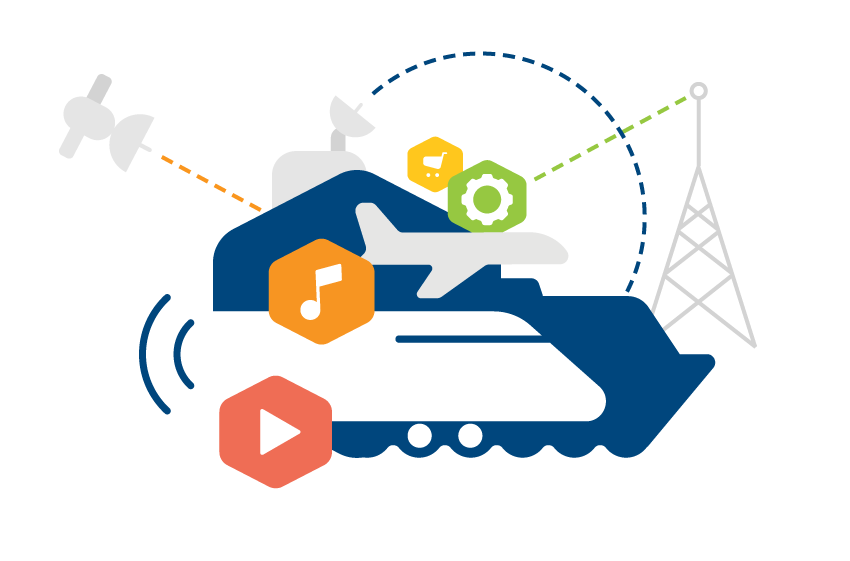

Transferring Securely and Robustly
Content Delivery For Modern Transportation
When it comes to mass transit, precision and robustness are the keywords. Everything is made failproof, from the overall design to the piece of software code that operates on-board systems. In the modern commercial transportation industry, including aviation, maritime, and railways, the increased availability of affordable connectivity options paves the way for the next generation of on-board services. The backbone of these smart IoT, on-board services, is a data transfer system that allows for content synchronization, allows contingencies, and utilizes multiple communication channels.
Modern transport vessels’ data requirements are pushing the traditional connectivity channels and transfer systems to their limits. The industry faces an issue of either using expensive and limited communication pipes for the transfer of data or make critical decisions at the gate to avoid expensive in-transit transfers. IP communication links, including 4G and 5G mobile technologies, have eased these issues to some extent.
Data Hurdle for On-Board Services
A modern commercial transport vessel comprises hundreds of digital systems that communicate amongst each other and with on-ground servers to ensure proper operations and safety. These systems vary according to the transport type. In aviation, they usually are - predictive maintenance, electronic flight bag, crew services, sensor, weather, traffic, navigation, IFE, and much more.
The rising expenses and thinning margins in the industry drive a constant search for effective means to reduce operational costs and value creation opportunities for passengers. The integration of various technologies by creating a seamless ecosystem of services and extracting additional usage from existing hardware is one method.
Choosing different data pipes depending on economics, data type and criticality, deployment of services, automating decisions, and harmonizing cockpit and cabin operations are also the further challenges that the transportation industry faces with data communication. Hardware posing as considerable limitations, owing to extensive compliance issues, out of the box thinking is required to create a solution that capitalizes on standardized digital protocols.
Anatomy of a Sync System
Axinom Sync is a solution that solves robust and secure data transfer, iterative updates, inter-connectivity, content synchronization, interruption management, etc. Along with domain architecture and test-driven workflows, Axinom Sync uses containerization for deployment across different platforms.
.png)
Two core Axinom services handle the workflow of Axinom Sync -
Axinom On-Board Cloud - Manages and deploys all kinds of content and service packages and integrations in a single place through a unified interface. The on-board cloud creates the packages of content sets and other digital services to be delivered to the vessel.
Axinom Sync - Carries out secure and robust bidirectional content synchronization using standardized communication protocols. It allows for fast and secure transfer of data in any environment.
It uses a web service API called Sync API to facilitate connectivity with Sync Storage, which is storage where all the data ready for uploading is stored. Sync Client, the primary synchronization service, handles all data transfers by communicating via the Sync API with Sync Storage.
Axinom On-Board Cloud, along with Axinom Sync, supports containerized deployment and orchestration of services to on-board servers, using Docker and Docker Swarm, providing the essential benefit of fast and scalable delivery and deployment.
Features that make our solution unique:
Choice of pipe - Depending on the availability of communication pipelines, according to data type, size, and criticality, Axinom Sync can select and switch between communication channels. It can manage the following pipes:
-
Cellular 4G/5G
-
Wi-Fi networks
-
Satellite
-
Physical storage devices like USB-stick, HDD, and SSD
-
Personal gadgets like crew phones, laptops, tablets
Security - For a secure transfer, Axinom Sync encrypts the content using strict encryption standards. Synchronization processes use smart control checksum approach to verify data integrity and identify differences and interruptions between sets of data, allowing optimal transfer approach applied to various connection types and connection quality.
Robustness - Built with Domain-Driven Design (DDD) with Test-Driven Development (TDD) workflow, the solution is tested for multiple contingencies with functional and non-functional automated tests.
Service Platform - As a perfect companion of a modern connected aircraft, Axinom Sync allows automatic deployment and orchestration of independent micro-services for multiple use-cases such as cockpit or cabin data, weather services, sensor systems, predictive maintenance, and many more.
Scalability - Axinom Sync can be scaled either horizontally or vertically. So, while some components reside in the cloud, others can work on-premise, or the whole system can be divided into multiple machines.
Bidirectional flow - It is designed to support the bidirectional delivery of content. Hence, uploading the content and data from on-ground servers and offloading data from the cockpit and cabin systems from on-board servers can be achieved seamlessly.
Incremental updates - To reduce the amount of data and time, Axinom Sync compares the content sets and updates only the modifications. All the while keeping track of content versions.
Interruption management - Axinom Sync manages disconnections or interruptions that happen during synchronization. It allows the successfully synchronized part of the content to be already used on board. Moreover, as soon as the allowed connection is available again, it resumes the synchronization.
Innovative Solution for Tomorrow
The present-day data delivery systems can’t cater to tomorrow’s transportation needs that are more akin to connected IoT devices. The sheer amount of agility and data needed makes current solutions obsolete.
Moving forward, we can see the need for quick and fast content and service delivery and deployment, while supporting the ever-growing amount of data across communication pipes. In contrast to the traditional methods, an automated solution like Axinom Sync can drastically reduce delivery cycles and enable revenue generation through ancillary mediums.








